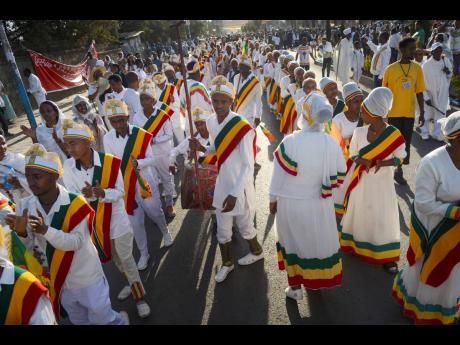The Nine Saints
A PLETHORA of sources say that The Ethiopian Orthodox Church (EOC) was established in the fourth century by St Frumentius and his brother, Aedesius. St Athanasius of Alexandria consecrated St Frementius as the first Bishop of Ethiopia during the reign of Emperor Ezana and Emperor Syzana.
St Frementius came to be known by the Ethiopians as Abba Selama, which means, ‘The Father of Peace’, and Kesate Berhan, meaning, ‘The Revealer of Light’. As the first bishop of Ethiopia, he was given the title, Abune, meaning, ‘Our Father’. He was succeeded by Bishop Minas, who was said to be of Egyptian origin. The Ethiopian Church from then on was administered from Alexandria, Egypt, and Ethiopians were not considered eligible for consecration as bishops. This policy existed for 1600 years.
Bishop Minas was a busy missionary who recorded his activities in the form of literary works, which were significant. Yet, the ‘Nine Saints’ are credited as the missionaries who spread the word more than any other. They came from the Byzantine empire about 479 AD. They to Axum where they were well received by Emperor Ella Amida and the people. They translated various sacred texts from Greek and Syriac into Ge’ez, spread the Gospel, and introduced a life of living in monasteries.
The most outstanding figures among the Nine Saints were Za-Mikael Aregawi, Pantalewon, Afse, and Garima. They came from different parts of the eastern Roman empire, such as Constantinople and Syria. They were all adherents to a particular doctrine for which they were persecuted by the Roman emperor. They went first to Egypt, and lived some years at the monastery founded by Pachomius, before moving on to Ethiopia. In Axum they studied the language and became familiar with the people and customs.
They eventually left for various places to preach and spread the Gospel, and establish monasteries. Only two of them, Abba Libanos and Abba Pantalewon, remained near Axum. Za-Mikael went to Debra Damo where he stopped the worshipping of serpents, and founded a monastery. Abba Pantalewon turned a pagan temple into a church. Abba Afse went to Yeha and transformed the famous temple there into a church.
The efforts of the Nine Saints to wipe out paganism did not result in their persecution and exile as they were protected and supported by the king.
The Nine Saints also contributed greatly to the development of Ge’ez worship and literature. Yet, it is said their major contribution was the translation of the Bible into Ge’ez. The work began partially during the time of Frumentius, when only a few of the basic books for worship, such as passages from The Psalms, were translated. They are also credited for translating the entire Bible. The Nine Saints also translated a number of basic religious works, both doctrinal and literary, in content into Ge’ez.
A Princeton University Website says, “Ge’ez, or Classical Ethiopic, is one of the ancient world’s major literary languages, with two millennia of history in the Horn of Africa and Arabia. The language appears in many ancient inscriptions and in Jewish and Christian writings, even shaping the language of the Qur’an and early Muslim religious texts. It continues to live on today as the liturgical language of the Ethiopian and Eritrean Orthodox churches.”
The Ethiopian Church entered a new phase during the sixth century, which is marked with the rise of St Yared, the founder of the Ethiopic Hymnody, which is a unique form of music that combines religious and secular elements. Saint Yared was a monk who lived in Axum, Ethiopia, and is considered one of the most important figures in Ethiopian music history. He is also known for his contributions to Ethiopian literature and poetry.
The fourth to the seventh century was a time when remarkable religious activities were undertaken. Ethiopia was considered as the centre of Christianity in the ‘Horn of Africa’ (Ethiopia and Eritrea in eastern Africa), which preserved its own Christian heritage and history, and became the emblem of religious independence for centuries.
For decades the Ethiopian Church has been known as the Ethiopian Orthodox Tewahedo Church. Tewahedo is a Ge’ez word meaning ‘being made one’ or ‘unified’. It refers to the Oriental Orthodox belief in the one composite unified nature of Christ. “A complete, natural union of the divine and human natures into one is self-evident in order to accomplish the divine salvation of humankind”, the church is maintaining.


